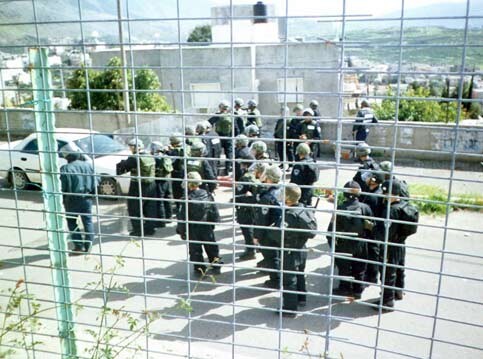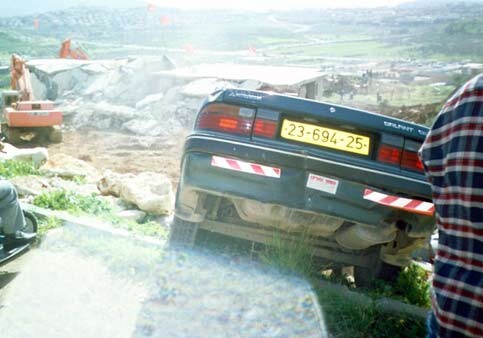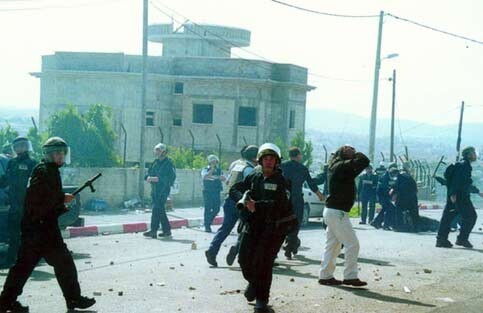14 May 2004
‘LET THEM SUFFOCATE’: POLICE BRUTALITY DURING HOUSE DEMOLITION IN UPPER GALILEE VILLAGE OF AL-BEA’NEH, FEBRUARY 25, 2004

A group of police congregate in preparation for their advance into Bea’neh. (HRA)
Executive Summary
This report examines in detail the behavior of the Israeli police in the enforcement of house demolitions in the Arab village of al-Bea’neh in the Upper Galilee on February 25, 2004. The Arab Association for Human Rights (HRA) based in Nazareth recognizes that house demolitions inside the state of Israel are a government policy directed almost entirely against the country’s Palestinian Arab citizens, who are both deprived of land on which to build homes and face grossly unfair obstacles to gaining permits to build on land they do own.
The HRA harshly criticizes Israel’s policy of systematically denying the Palestinian Arab minority citizens, which make up approximately 20% of the whole population, their basic human rights to an adequate standard of housing and living and the right to integrity of the private sphere. In particular the HRA condemns the manner in which these demolition operations are carried out.
The purpose of this report is not to consider the justice of the claims of the five families in al-Bea’neh who lost their homes. Rather it is to focus on the continuing brutal mistreatment of Israeli citizens belonging to the Palestinian Arab minority by the country’s security forces. One of the major confrontation lines between the police and the Palestinian Arab minority is over the enforcement of house demolitions. It is clear from the testimonies contained in this report that the police continue to regard the Palestinian Arab population as “enemies” who can be handled only through the excessive use of violence.
What makes the evidence contained in this report so alarming is that the Israeli police appear not to have internalized the lessons of October 2000, when they shot dead 13 unarmed Palestinian Arab citizens during demonstrations.
Afterwards, a state commission of inquiry, the Or Commission, heard evidence that police had used excessive and lethal force in non-threatening situations. Senior police commanders promised to change a police culture that has traditionally viewed Palestinian Arab citizens as an enemy.
The problems were highlighted again last year when the Or Commission published its report into the October events. Justice Theodor Or warned: “The police must realize that the Palestinian Arab sector in Israel is not the enemy and must not be treated as such.” He also observed that “the police must raise the level of dialogue between its officers and the leaders of the [Palestinian] Arab community.” He concluded: “It is important to plant an understanding in all ranks of the police of the need for calm and moderate conduct vis-a-vis the Palestinian Arab sector. At the same time, it is important to uproot the instances of bias against the Palestinian Arab sector that were revealed even among veteran and respected police officers.”
Justice Or, however, feared that “the culture of drawing conclusions by the police from the events of October 2000 is not deeply rooted.” The police tactics used in al-Bea’neh confirm that not only is such a culture not deeply rooted but that it may be non-existent. All the mistakes of police over-reaction demonstrated in October 2000 were repeated at al-Bea’neh.

A car pushed off a residential road in Bea’neh by the police. (HRA)
According to the testimonies, the police remained in the village for nearly two and a half hours after the demolitions were complete and continued to attack residents. The need for the police’s continuing, inflammatory presence after their work had been carried out must be questioned. Justice Or’s point about the need for encouraging dialogue between the police and the Palestinian Arab leadership appears to have been ignored too. A delegation including the head of the municipal council was sprayed with a yellow-colored liquid used for riot control when they tried to approach commanders to calm the situation. At least two members of the delegation were also viciously attacked by police without provocation during the negotiations.

Ahmed Qasem Bakri, a member of a council delegation that tried to negotiate with police commanders, after a beating by the border police. A hospital report said he had received blows to the back of the head and on the left eyebrow, was suffering internal bleeding in his eye, had a broken nose and rib and a probable fracture to the right side of the face, as well as bruises and cuts all over his body. (Sout al-Balad)
It is also clear that in declaring an area of the village a “restricted zone”, the police commanders gave sanction to officers to use violence against anyone within that cordon, however legitimately they were there. Thus, Lateefa and Alia Titi both describe how police forced their way into their home - which was inside the restricted zone but unconnected to the demolition - and attacked the men and women inside. The violent assault on the family by several policemen occurred in front of the family’s children, which included a twoweek- old baby. The police also fired tear gas indiscriminately at the house, without regard for the possible lethal effects of the gas on young children trapped in a confined space.[1] There is also evidence suggesting that the children have been traumatized by this display of unprovoked violence.
The testimonies collected by the HRA fieldworkers in the week following the demolitions also show that police besieged a kindergarten, trapping several dozen small children in the building while they fired tear gas indiscriminately in the area. Several of the children had panic attacks and problems breathing because of the large quantities of gas being fired close to the kindergarten. The kindergarten principal, Fatmah Saleh Bakri, who tried to remonstrate with the police and warned them that the children were suffocating inside, was told “Let them suffocate”. When she continued to plead with the officers, a policeman pointed his gun directly at her face.

To the right of the picture, Ahmed Qasem Bakri is being beaten by police as he lies on the ground. In the foreground, a policeman aims a
teargas gun at the photographer. (Sout al-Balad)
Like many other witnesses, Fatmah Bakri says she was verbally assaulted by police. In a telling remark, one officer said to her “You saboteurs. We will demolish all your houses.” The institutional racism of the police towards Palestinian Arab citizens - which Justice Or identified as infecting the most senior levels of command - is still prevalent.
The nature of the operation, including the declaration of a restricted zone, suggests that it was carefully planned in advance and authorized at the highest levels. It is clear that the hostile attitude of the Israeli police towards the Palestinian Arab minority citizens is institutionalized in character and not the result of individual misdemeanors or misconduct. It is telling that several witnesses refer to the police as “soldiers” or “troops”, which reveals their perception of internal law enforcement when it is applied to their communities. The police who enter Palestinian Arab villages are invariably paramilitary forces, usually drawn from the Border Police which also operates in a semimilitaristic fashion inside the occupied West Bank and Gaza.
The testimonies of the al-Bea’neh residents suggest that the demolition operation was designed not only to tear down houses but to incite fear among the villagers. The HRA believes that the case of al-Bea’neh is part of a worrying development in Israeli policy which seeks to collectively marginalize and criminalize the Palestinian Arab minority inside Israel. The growing number of house demolitions and the manner in which they are carried out justifies the Palestinian Arab citizens’ fear that they are viewed as an unwelcome demographic threat to the Jewish character of Israel.
In light of the events that took place in al-Bea’neh, it appears that the recommendations of the Or Commission are not only being disregarded but reversed. The current provocative displays of violence by the police mirror the events in the early months of 2000 that led to lethal confrontation between the police and Palestinian Arab citizens in October 2000. During that period, the police repeatedly used violence in the Galilee while enforcing a widespread policy of house demolitions, leading to huge antagonism between the Palestinian Arab minority and the security forces. The HRA therefore believes that an in-depth investigation of the al-Bea’neh case is needed urgently.
Endnotes
1. It should be noted that some of the spent tear gas canisters collected by the HRA on the day of the event were made in the United States.
Related Links
“Let Them Suffocate” is the first in a series of case studies by the Arab Association for Human Rights in Nazareth that documents instances of human rights abuse committed against the Palestinian Arab minority in Israel. The purpose of the report is to focus on the continuing brutal mistreatment of Israeli citizens belonging to the Palestinian Arab minority by the country’s security forces. One of the major confrontation lines between the police and the Palestinian Arab minority is over the enforcement of house demolitions, and it is clear from the testimonies contained in the report that the police continue to regard the Palestinian Arab population as “enemies” who can be handled only through the excessive use of violence. “Let Them Suffocate” was produced by the HRA’s new Research and Reporting unit, a human-rights monitoring program whose methodology relies on field research and interviews and legal analysis of domestic and international human-rights standards.